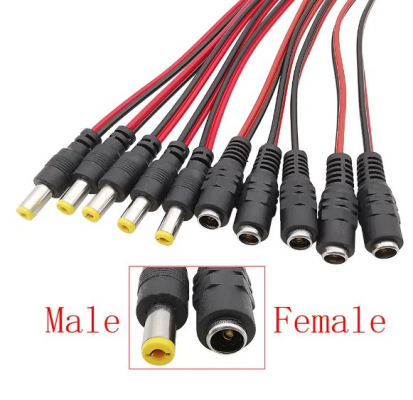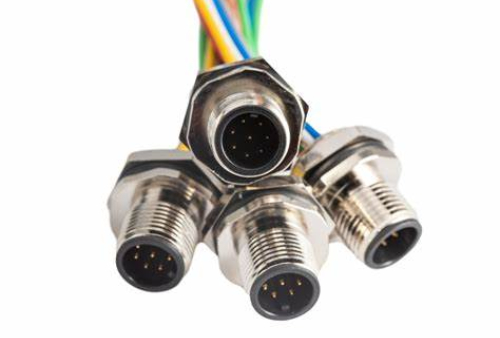What are pigtail connectors? Imagine them as short, pre-wired extensions with one connector on each end. They typically have a male and a female end, allowing you to easily link up different components or extend reach to existing connections.
The Types Of Pigtail Connectors

Pigtail connectors are commonly used in electrical and electronic applications to connect or extend wires. There are several types of pigtail connectors used for various purposes. Some common types include:
-
Wire Nut Pigtail Connector: This type of connector is designed to twist together and secure multiple wires. It typically consists of a plastic cap with an internal coil that helps to connect and insulate the wires.
-
Bullet Pigtail Connector: Bullet connectors are cylindrical in shape with a male/female configuration for quick and easy connections. They are commonly used in automotive applications and low-voltage electrical systems.
-
Spade Pigtail Connector: Spade connectors have a flat, spade-shaped metal piece that is crimped or soldered onto a wire. They are typically used to connect wires to screw terminals on devices such as switches and outlets.
-
Ring Pigtail Connector: Ring connectors have a circular shape with a hole in the middle for securing the connector with a screw or bolt. They are commonly used for grounding applications and in situations where a secure connection is required.
-
Butt Pigtail Connector: Butt connectors are used to splice or connect two wires end-to-end. They typically have a sleeve that is crimped onto the wires to create a secure connection.
-
Pin Pigtail Connector: Pin connectors have a cylindrical shape with a small metal pin projecting from the end. They are commonly used in automotive and industrial applications for connecting wires to sensors and other devices.
-
Twist-Lock Pigtail Connector: Twist-lock connectors have a threaded design that allows for quick and secure connections. They are commonly used in commercial and industrial applications for power distribution and control.
These are just a few examples of the types of pigtail connectors available. The specific type of connector to use will depend on the application and requirements of the electrical or electronic system being worked on.

How Do Pigtail Connectors Work
Pigtail connectors are commonly used in electrical and electronic applications to connect multiple wires. Here is a general overview of how pigtail connectors work:
-
Purpose: Pigtail connectors are used to provide a secure and reliable connection between multiple wires. They are typically utilized in scenarios where multiple wires need to be connected to a single terminal or device.
-
Construction: Pigtail connectors consist of a short wire (the "pigtail") with a connector attached to one end. The other end of the pigtail is typically stripped of insulation to expose the metal conductor, allowing it to be connected to other wires, terminals, or components.
-
Installation:
- To use a pigtail connector, you first strip the insulation from the end of the wire(s) that you want to connect.
- Next, you twist the exposed metal conductors of the wire(s) together with the pigtail wire.
- After twisting the wires together, you use a wire nut or another type of connector to secure the connection. This ensures that the wires are electrically connected and well-insulated.
- The pigtail can then be connected to the desired terminal or device, providing a secure and reliable electrical connection.
-
Advantages:
- Simplicity: Pigtail connectors are simple to use and install, making them a convenient choice for connecting multiple wires.
- Reliability: When properly installed, pigtail connectors create a secure and stable electrical connection.
- Versatility: Pigtail connectors can be used in various applications, such as electrical wiring, lighting fixtures, appliances, and more.
-
Applications:
- Pigtail connectors are commonly used in electrical wiring for outlets, switches, lighting fixtures, and other electrical devices.
- They are also used in electronic applications where multiple wires need to be connected to a single point, such as circuit boards or components.
Overall, pigtail connectors provide a practical solution for connecting multiple wires in electrical and electronic applications. By following proper installation techniques, you can ensure a safe and reliable electrical connection using pigtail connectors.
What Are Pigtail Connectors Used For
Pigtail connectors serve various functions in electrical and electronic applications due to their versatility and practicality. Here are some common uses of pigtail connectors:
-
Electrical Wiring: Pigtail connectors are frequently used in electrical wiring applications to connect multiple wires together. They are commonly employed in residential and commercial settings for tasks such as connecting light fixtures, outlets, switches, and junction boxes.
-
Grounding: Pigtail connectors are often used for grounding purposes in electrical systems. They help in creating a secure connection between multiple ground wires and a grounding terminal or device, ensuring proper grounding of electrical circuits.
-
Lighting Fixtures: In lighting installations, pigtail connectors are used to connect the wiring from the light fixture to the electrical wiring in the building. They provide a reliable connection and help ensure proper functioning of the lighting system.
-
Appliances: Pigtail connectors are used in appliances to connect various wires within the appliance or to establish external connections. They help in maintaining electrical continuity and ensuring that the appliance operates safely and efficiently.
-
Electronics: In electronic applications, pigtail connectors are used to connect multiple wires to components on circuit boards or other electronic devices. They provide a convenient way to establish electrical connections while maintaining a neat and organized wiring layout.
-
Automotive Wiring: Pigtail connectors find use in automotive wiring for connecting various electrical components, sensors, and circuits in vehicles. They help simplify the wiring process and facilitate secure connections in automotive electrical systems.
-
Renovation and Repair: During renovation or repair projects, pigtail connectors are used to replace old or damaged wiring connections. They enable electricians and DIY enthusiasts to make secure and reliable electrical connections without the need for extensive rewiring.
-
Networking and Telecommunications: In networking and telecommunications applications, pigtail connectors are used in fiber optic and Ethernet installations to create connections between cables and network devices. They help maintain signal integrity and facilitate efficient data transmission.
Overall, pigtail connectors play a crucial role in various electrical and electronic applications by facilitating secure and reliable connections between multiple wires. Their versatility, ease of use, and effectiveness make them a popular choice for a wide range of wiring tasks across different industries and settings.
Tips for choosing a pigtail connector
When selecting a pigtail connector for your electrical or electronic project, consider the following tips to ensure you choose the right connector for your specific needs:
-
Compatibility: Ensure that the pigtail connector you choose is compatible with the wire gauge and type you will be connecting. Different connectors are designed for specific wire sizes and types, so verify that the connector matches your requirements.
-
Insulation: Choose a pigtail connector with proper insulation to ensure electrical safety and prevent short circuits. Insulated connectors protect against accidental contact with live wires and provide an added layer of protection.
-
Quality: Opt for high-quality pigtail connectors from reputable manufacturers to ensure durability and reliability. Quality connectors are less likely to fail prematurely and offer better performance over time.
-
Connector Type: Select the appropriate connector type for your application. Common pigtail connector types include wire nuts, crimp connectors, terminal blocks, and solder connectors. Choose the type that best suits your specific wiring needs.
-
Application: Consider the specific application for which you need the pigtail connector. Whether you are connecting wires in a residential electrical installation, automotive wiring, electronic circuitry, or telecommunications network, choose a connector that is designed for that particular application.
-
Quantity: Determine how many wires you need to connect and choose a pigtail connector that can accommodate the required number of wires. Some connectors are designed for multiple wires, while others are better suited for connecting fewer wires.
-
Ease of Installation: Select a pigtail connector that is easy to install, especially if you are not familiar with complex wiring procedures. Different connectors require varying installation methods, so choose one that matches your skill level and comfort with wiring tasks.
-
Waterproofing: If your application requires protection against moisture or exposure to the elements, consider using waterproof pigtail connectors. Waterproof connectors help prevent corrosion and ensure reliable connections in outdoor or wet environments.
-
Certifications: Look for pigtail connectors that meet industry standards and certifications for safety and performance. Choosing connectors that comply with relevant regulations will help ensure the safety and reliability of your electrical or electronic connections.
By considering these tips when selecting a pigtail connector, you can make an informed decision and choose a connector that meets your specific requirements, ensuring a secure and reliable electrical or electronic connection for your project.
Conclusion
In conclusion, selecting the right pigtail connector is crucial for ensuring safe and reliable electrical connections in various applications. By considering factors such as compatibility, insulation, quality, connector type, application, quantity, ease of installation, waterproofing, and certifications, you can make an informed choice that meets your specific project requirements.
Choosing a high-quality pigtail connector from a reputable manufacturer, suited to your wire gauge and application, will help prevent issues such as short circuits and unreliable connections. Additionally, opting for connectors with proper insulation and waterproofing capabilities, as needed, can enhance the longevity and safety of your electrical or electronic connections.
By keeping these considerations in mind and selecting the appropriate pigtail connector for your project, you can ensure a secure, durable, and efficient wiring solution that meets your needs and adheres to industry standards for safety and performance.



